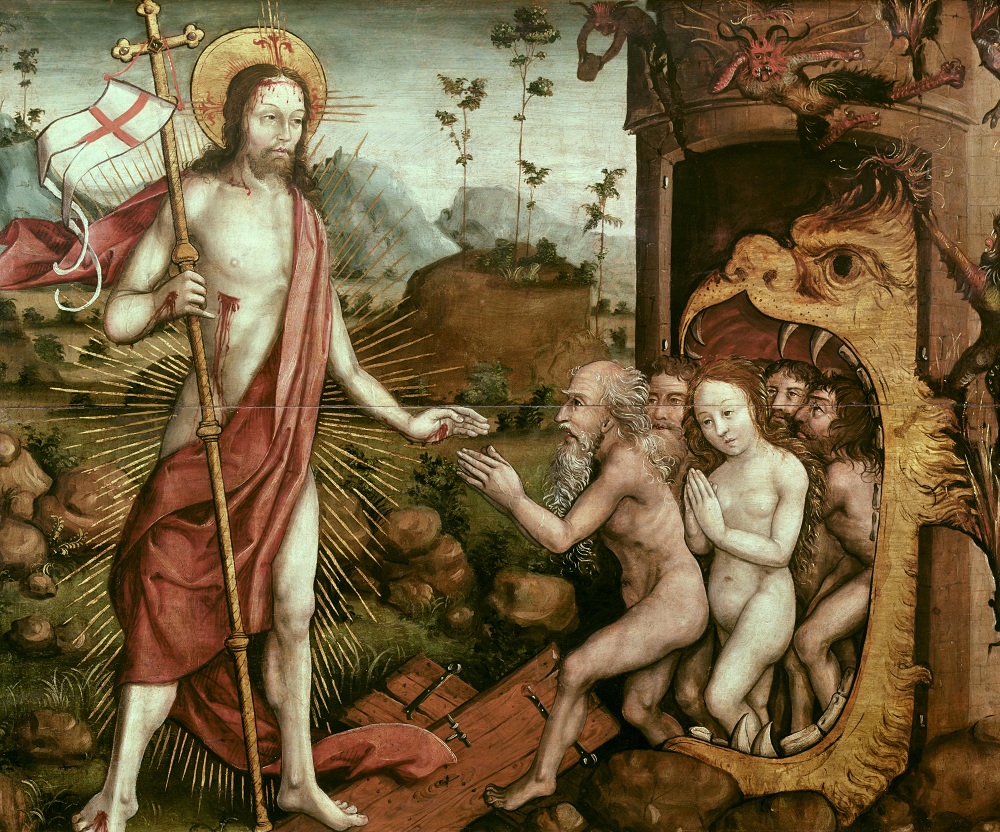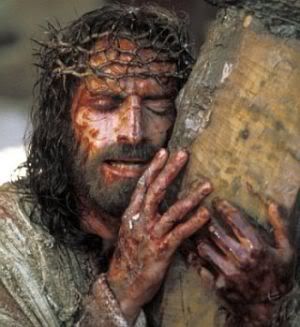It is said that when St. Thomas Aquinas "submitted" his writings on the Eucharist before the crucifix one day, our Lord actually came down from the cross and expressed his approval of his writings; "Thomas, you have written well on the Mystery of my Body and Blood." I am not quite sure how that event might have looked from the perspective of those who witnessed it (apparently some of his Dominican brothers were the ones that testified to these events), but what I can most certainly say is that it wasn't the first or last time that a crucifix spoke to a devotee. Now I am not suggesting that these kinds of miraculous exchanges happen all the time- rather what I am saying is that the crucifix is a most eloquent instructor (St. Augustine called it a pulpit) that speaks even when it says nothing at all. Below I present, in brief, eleven things I myself have learned from this unusual, though occasionally chatty, pedagogue.
1. The Cross as a "Garden Stake" in a Graveyard

2. The Crucifix as a Gestalt Switch

Some crucifixes present Jesus as if he is some kind of "holy diver" about ready to plunge into the abyss of death in order to fish man out of his hellish prison. On other crucifixes the cross seems to me to be a vehicle for flight. In this particular vision, instead of a piece of dead wood, I see the wood of the cross as a pair of wings, and Jesus frozen for a moment in time before he soars through the roof of the night. Which of these visions is correct? Yes.
3. The Crucifix as the Ultimate "Shape" of Paradox

Obviously there is no greater paradox than the belief that we should receive eternal life in exchange for killing God. The cross boasts numerous paradoxes in connection with the subsequent death and resurrection of Jesus Christ, but even more than that, the shape of the cross itself actually provides a visual definition of what we mean when we say that the cross is a paradox. What is a paradox? It is an apparent contradiction that when considered more closely actually reveals the answer to a riddle. In other words, the deepest truths seem contradictory and absurd at first glance (i.e. they "cross" or contradict one another). However, when you look more closely at them you realize that while ordinarily there is nothing in common between them (i.e. life and death), yet in one unusual instance they really do "intersect" and do have something in common.
4. The Cross and Jesus Barring the Way to the Tree of the Knowledge of Good and Evil
In the garden of Eden, Adam was blatantly derelict of his duties to Eve. In fact, apparently he just stood there and watched as Eve destroyed herself, and then politely and quietly endorsed the project… only to blame both Eve and God when confronted with his cowardice. By contrast, the Second Adam shows the first one (me) how it's done. Indeed, this second "Adam" is so horrified by the prospect of the New Eve "tasting" death he himself bars the way to the tree of death, preferring instead his own crucifixion, to her demise. In this "still life" of the New Adam's passion, we see his love for his bride immortalized.
5. The Crucifix and the Priestly Orans
Just as each priest holds his hands differently when he is praying the prayers of the mass, so each crucifix is unique in the same way. If the priest wants a simple definition of who he is to be, let him understand that the reason he is to hold his hands so often in this manner is because he is to lead a cruciform existence. There is no more priestly moment in Christ's life than when his arms are stretched wide open and nailed for all of eternity in the orans position on the cross.
6. Jesus and the Piece of Dead Wood that Is Me
The cross is not incidental to the story of Jesus' life, death, and resurrection. Imagine if Jesus had simply died on the road to Calvary- how inspiring would a statue of a man dead on the ground be? No, in order for him to draw all men to himself, he had to be exalted on this most unusual of thrones. However, another way to see this burden is not only in the spirit of obligation, but strangely enough as an embrace. To my eyes this piece of dead wood represents the Bride of Christ, and Jesus carrying her to Calvary, not only to exalt her, but in order to implicate himself so closely to her that the two become one. What a bizarre fairy tale- the wedding of the Prince of Peace and the Princess, who, because of an ancient curse, had been reduced to little more than a piece of splintering driftwood. This must be the explanation for why this great prince seems to embrace it with such passion and affection.
7. The Cross as the Hilt of a Sword

In days of yore when one conquered a particular territory, it was customary to lodge one's sword into the soil so that only the hilt of the sword was seen. In the case of the cross we have a strange declaration of victory indeed. For the sword hilt in this particular instance appears to be the sign of the devil's victory, and not the Lord's. Yet in a strange twist of fate that no one could have envisioned (especially the devil), this sign of failure turns out to be the ultimate symbol of triumph. Yes, by defeating God, the devil himself actually sealed redemption for man. And by the devil marking his territory with the hilt of the cross, he actually assisted in the re-dedication all of humanity, along with the earth, to God.
8. The Crucifix as the Abiding Connection between Theology and Morality
Just as on the cross Christ is suspended between heaven and earth, so also we recognize in that self same cross a bridge between heaven and earth. Yet this bridge not only symbolizes the pathway that God reforged from earth to heaven, but (among other things) the bridge between the theology surrounding the nature of God and that which shows the highest virtue of men. More often than not, Christians fail to see the connection between the Creed and morality. What does believing in God have to do with what I do with my body? And yet there it is at the cross explained in full, the marriage of who God is, and the explanation of who we were/are supposed to be. Who is God? Look at the cross. How are we supposed to live? Look at the Cross. "This is my body given up for you. Do this in memory of me." This is not only a liturgical command, but a moral command.
9. The Cross and the Basic Architecture of Everything


10. The Cross and the Rise of the Everlasting Phoenix

The Sunday before Good Friday is, depending on your point of emphasis, either Passion Sunday or Palm Sunday. The most obvious reason for referring to it as "Palm Sunday" might seem obvious enough. Jesus came into Jerusalem and the inhabitants of the city celebrated his arrival by waving palm branches in the air, presumably because they believed, at least on some level, that he was the long awaited Messiah. Interestingly, in the Mediterranean world, palms represent a sign of victory, of peace, and even of immortality. Another interesting detail that emerges from the exploration of this ancient symbolism actually comes from science. "Phoenix"is the category of plant (more specifically, the genus) under which the palm is frequently identified. Coincidence? Apparently not- the Greek myth surrounding the story of this mythical bird holds that every five hundred years (at the end of its life span), it flies to the Heliopolis in Egypt, makes a nest atop a palm tree, dies, then rises from the very same body that perished. Another version suggests that the bird (likewise at the end of its life), is immolated on an altar, only to rise again from that very same altar of sacrifice. The point here is not so much to get lost in the myth (though it is a cool one for many reasons), but to realize the fascinating association one can make between the waving of something so simple as a palm branch, and the down right combustible image of Christ's arms outstretched like an immortal Firebird, sacrificed atop a sacred tree, and promising to rise again in perpetuity.
11. The Shadow of the Cross and the "Overshadowing" at the Annunciation

When Mary is visited by the Archangel Gabriel and told of her special election, she inquires as to how this will all come about, being that she is a virgin. The angel explains; "The Holy Spirit will come upon you, and the power of the Most High will overshadow you."(Luke 1:35) Most notably, in the Old Testament this "overshadowing" generally took place whenever God wanted to verbally communicate with the Israelites. The Ark (as well as the Meeting Tent) would be "overshadowed" with a sacred cloud, which, in a wholly unique way, indicated that God's power and Presence was proximately among them. Consequently, when similar language is used in the Gospel of Luke to indicate that Christ (the Word of God) would ultimately be made present in the womb of Mary (much like the Ark), the goal of the Gospel writer was demonstrate the continuity and fulfillment of God's plan with regard to the New Covenant. In any case, there is another fascinating parallel here, one that I had not considered until today. If Jesus was hung upon the cross in infamy in the shape of a soaring bird, then might we also envision what those "overshadowing" wings would have looked like from Mary's perspective. Indeed, imagine for a moment, the Real Presence of God speaking the words of life from that exalted pulpit on Calvary, brooding over her like some Holy Bird from heaven, inaugurating a kind of second-wave Annunciation with these words; "Then he said to His mother, “Woman, behold your son!” and to his disciple, “Behold your mother!” John 19:26-27





No comments:
Post a Comment